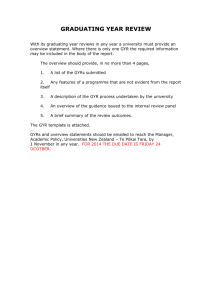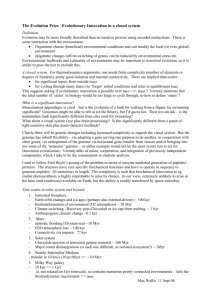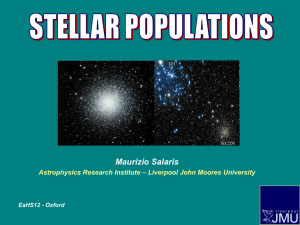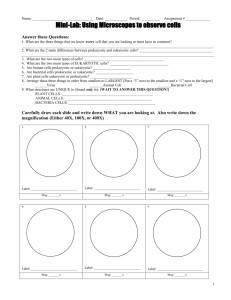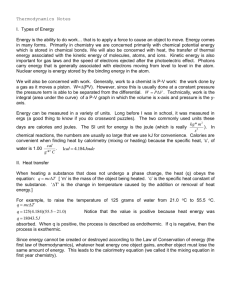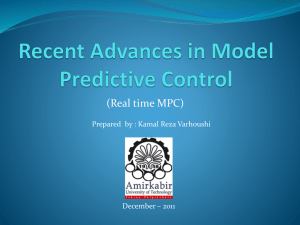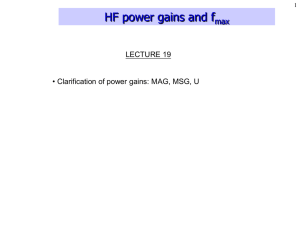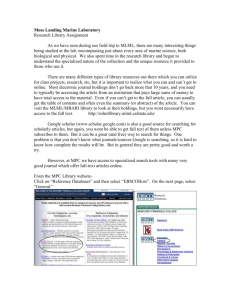Solutions
advertisement
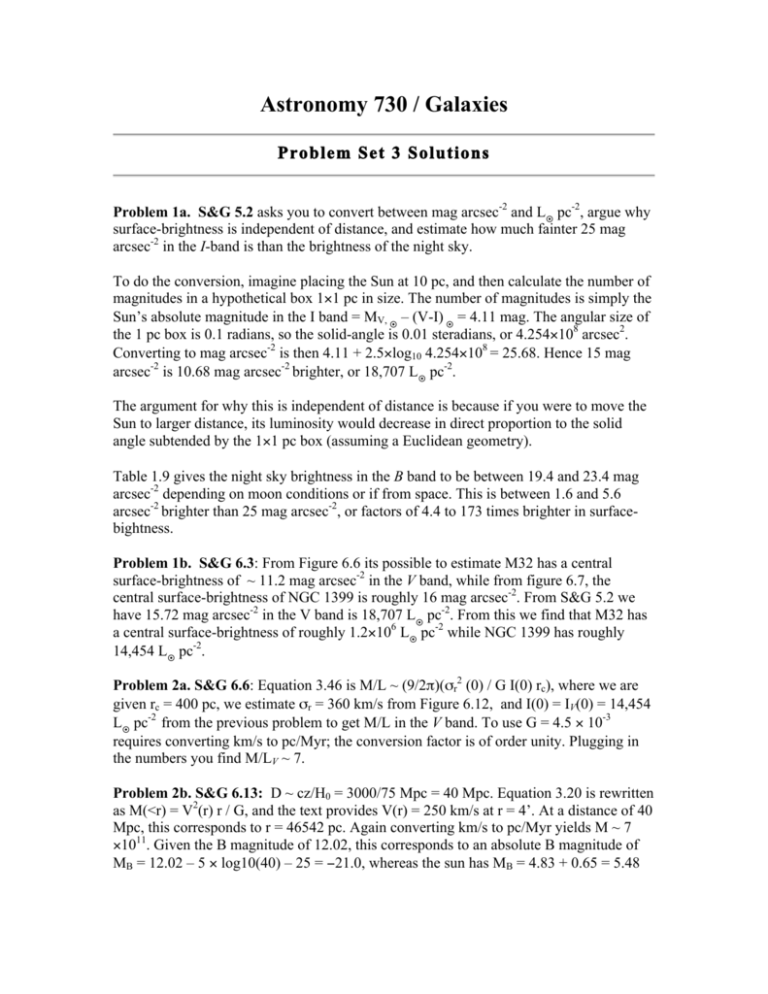
Astronomy 730 / Galaxies
Problem Set 3 Solutions
Problem 1a. S&G 5.2 asks you to convert between mag arcsec-2 and L pc-2, argue why
surface-brightness is independent of distance, and estimate how much fainter 25 mag
arcsec-2 in the I-band is than the brightness of the night sky.
To do the conversion, imagine placing the Sun at 10 pc, and then calculate the number of
magnitudes in a hypothetical box 1×1 pc in size. The number of magnitudes is simply the
Sun’s absolute magnitude in the I band = MV, – (V-I) = 4.11 mag. The angular size of
the 1 pc box is 0.1 radians, so the solid-angle is 0.01 steradians, or 4.254×108 arcsec2.
Converting to mag arcsec-2 is then 4.11 + 2.5×log10 4.254×108 = 25.68. Hence 15 mag
arcsec-2 is 10.68 mag arcsec-2 brighter, or 18,707 L pc-2.
The argument for why this is independent of distance is because if you were to move the
Sun to larger distance, its luminosity would decrease in direct proportion to the solid
angle subtended by the 1×1 pc box (assuming a Euclidean geometry).
Table 1.9 gives the night sky brightness in the B band to be between 19.4 and 23.4 mag
arcsec-2 depending on moon conditions or if from space. This is between 1.6 and 5.6
arcsec-2 brighter than 25 mag arcsec-2, or factors of 4.4 to 173 times brighter in surfacebightness.
Problem 1b. S&G 6.3: From Figure 6.6 its possible to estimate M32 has a central
surface-brightness of ~ 11.2 mag arcsec-2 in the V band, while from figure 6.7, the
central surface-brightness of NGC 1399 is roughly 16 mag arcsec-2. From S&G 5.2 we
have 15.72 mag arcsec-2 in the V band is 18,707 L pc-2. From this we find that M32 has
a central surface-brightness of roughly 1.2×106 L pc-2 while NGC 1399 has roughly
14,454 L pc-2.
Problem 2a. S&G 6.6: Equation 3.46 is M/L ~ (9/2π)(σr2 (0) / G I(0) rc), where we are
given rc = 400 pc, we estimate σr = 360 km/s from Figure 6.12, and I(0) = IV(0) = 14,454
L pc-2 from the previous problem to get M/L in the V band. To use G = 4.5 × 10-3
requires converting km/s to pc/Myr; the conversion factor is of order unity. Plugging in
the numbers you find M/LV ~ 7.
Problem 2b. S&G 6.13: D ~ cz/H0 = 3000/75 Mpc = 40 Mpc. Equation 3.20 is rewritten
as M(<r) = V2(r) r / G, and the text provides V(r) = 250 km/s at r = 4’. At a distance of 40
Mpc, this corresponds to r = 46542 pc. Again converting km/s to pc/Myr yields M ~ 7
×1011. Given the B magnitude of 12.02, this corresponds to an absolute B magnitude of
MB = 12.02 – 5 × log10(40) – 25 = −21.0, whereas the sun has MB = 4.83 + 0.65 = 5.48
mag. The difference in magnitudes is roughly 4 x 1010, which is the result leading to
M/LB ~ 18.
Problem 2c. S&G 6.14. Adopting σr ~300 km/s as a reasonable average over the profile
in Figure 6.12, we find VH = 424 km/s. Using the mass formula from the previous
problem, and again converting to pc/Myr, we find M ~ 2 × 1012 M within r = 50 kpc.We
are given that NGC 1399’s MV = -21.7, which we can compare to the Sun’s value of
4.83 mag. The difference is equivalent to about 4.1 × 1010 L, which yields M/L ~ 50 in
the V band.
Problem 3a. If M/L is 5 times greater for ellipticals at z=1, 8 Gyr in the past, than that
implies the luminosity was 5 times higher, assuming the total mass was constant. We are
given the numbers that a single burst fades in the B band by about a factor of 3.3 from 0.1
to 1 Gyr, and then another factor of 3 from 1 to 10 Gyr. Since we need a factor of 5
fading over 8 Gyr, then we must be seeing the ellipticals at z=1 at an age < 1 Gyr at that
redshift.
b. Reasonable estimates for the best single-star fits to the spectra in 6.17 and 6.18 are Kgiant for the elliptical spectrum, B star for 10 Myr, A star for 100 Myr, F star for 1 Gyr,
and somewhere between G and K for 10 Gyr (hard to tell given the scale).
c. Figure 6.19 clearly shows that composite stellar types are needed to match both optical
and infrared colors. However, given the limited spectral range in Figure 6.17 and 6.18,
the one-star mix may not be that bad. For the older stellar populations (and the elliptical),
a combination of A+F, F+K, G+K might be a better match. The reasoning is based on
what we know about main-sequence lifetimes, and that by 1 Gyr the RGB develops.
d. The point here that is relevant for the term project is that you can devise a very simple
stellar mix to characterize a simple stellar population of a given age. That means that for
the composite stellar population, your book-keeping (the relative numbers of different
stars in your model, and the total number of spectral types) can be minimized.
Problem 4 (a): Since Σdisk ∝ σz2 / hz in general for a disk; we assume that today the
vertical exponential scale-height, hz is constant with radius; and Σdisk = Σ = Σ0 exp(−R/hR),
where Σ0 is the central mass surface-density and hR is the radial disk scale length; it
follows that σz ∝ [hzΣ0 exp(−R/hR)]1/2. From this it directly follows that σz(R,t0) = σz(0,t0)
exp(−R/2hR), or in other words σz has an exponential radial distribution with twice the
scale-length as the mass. σz(0,t0) is left to be defined, and will vary for different stellar
types. However, σz(0,t0) can be determined by taking the value for stars at the solar
radius, and knowing the scale-length of the disk. For the Milky Way, if we take the value
for old stars in the thin disk at R0 ~ 8 kpc (the solar radius), we have σz(R0,t0) ~ 20 km/s.
For the Milky Way hR ~ 3 kpc, so σz(0,t0) ~ 76 km/s (we refine these numbers below).
(b) σz(R,t) = σb (1+t/τH)1/n, where n (the diffusion index) and τH (the heating time-scale)
are, in general, functions of radius and time such that σz(R,t) = σz(0,t) exp(-R/2hR) and
Σdisk ∝ σz(R,t)2 / hz(R,t). At t = 0 the boundary conditions are σz(R,0) = σb and hz(R,0) =
zb. At t = t0 the boundary conditions are that σz(R, t0) = σz(0, t0) exp(−R/2hR) and hz(R,
t0) = constant. If we take σz(R0,t0) = 20 km/s, we know that hz(R, t0) = 350 pc, again
based on the old stars in the thin disk in the solar neighborhood.
(c) Equate σz(R, t0) = σz(0, t0) exp(-R/2hR) with σz(R, t0) = σb (1+ t0/τH)1/n and solve for n
to find the radial dependence of n assuming constant τH. This yields n = log10(1+ t0/τH) /
log10 [σz(0, t0) exp(−R/2hR) / σb]. This yields a linear relation for 1/n as a function of R:
1/n ≡ y(R/hR) = a(R/2hR) + b, where a = −0.4343 / ζ, b = log10 [σz(0, t0) / σb] / ζ, and ζ =
log10(1+ t0/τH).
(d) Following the same equality, but solving for τH(R) = t0 {[σz(0, t0) exp(−R/2hR) /
σb]n−1}-1. In both of the cases here, we have found a solution for n and τH that effectively
time-averages from t = 0 to t0. If we were to consider σz(R,t) = σb (1+t1/τH,1)1/n1 × . . . ×
(1+tm/τH,m)1/nm, i.e., a discrete product of m different time-intervals such that the sum of t1
+ … tm = t0, we could solve for τH(R,ti) and n(R,ti) for any arbitrary set of time-intervals.
(e) The dynamical time-scale tdyn of the disk is comparable to the free-fall time-scale or
toughly ¼ of the characteristic orbital period. The latter is the easiest to calculate. You
may have wondered what is the relevant orbital period, i.e., the radial orbit (TR = 2πR/Vc,
where as usual Vc is the circular speed of the potential at radius R in the disk), or the
vertical orbit (Tz ∝ hz/σz). The physical picture is that diffusion arises from the
interaction between stars and either molecular clouds, spiral arms, or satellites that
changes over time due to differential rotation. In this case, it’s the difference between the
orbital periods in radius that are likely to count most. For the Milky Way we can safely
assume that Vc ~ 220 km/s outside of the innermost regions of the disk; this is certainly a
safe assumption for R/hR = 1 and 3. For the MW, setting hR = 3 kpc then tdyn ~ 0.021 Gyr
at R/hR = 1, and tdyn ~ 0.063 Gyr at R/hR = 3, and we take these as τH(R) for all time, t.
What we need to do is build a model such that starting with σb and zb at every radius, the
diffusion at each radius is tuned to give the appropriate scale-height, hz, for a given age of
the disk, but that is always constant with radius. Since Σdisk ∝ σz2 / hz , alternatively we
can couch the required heating in terms of how σz changes, which is exactly what we did
in (c). We use this relationship for n with τH(R) = tdyn, and set σz(0, t0) for the relevant
value of hz for a given t0. Referring to Table 2.1 of S&G, we can take hz = 280, 300, 350
pc and σ z(R0, t0) = 13, 19, 21 km/s for mean ages of roughly 3, 6, and 10 Gyr. Also
following from this table we can adopt σ b and zb to be that of the cold gas, with values of
6 km/s and 65 pc. In our formulation in (c), it turns out we only need to know σb because
again Σdisk ∝ σz2 / hz and we are assuming Σdisk is constant with time. The following table
steps through the calculation for 1/n ≡ y(R/hR) = a(R/2hR) + b:
log10
[σz(0, t0)/σb]
R/hR =1
R/hR=3
1/n = a(R/2hR) + b
R/hR = 1 R/hR = 3
0.91
1.08
1.12
2.16
2.46
2.68
1.69
1.98
2.20
0.32
0.35
0.34
ζ
t0
hz
(Gyr) (pc)
3
280
6
300
10
350
σz(R0, t0)
(km/s)
13
19
21
σz(0, t0)
(km/s)
49.3
72.1
79.7
0.16
0.22
0.21
The larger values of 1/n in the previous draft were due to taking tdyn at R = 1 and 3 kpc
instead of R/hR = 1 and 3. The values for all R are plotted below. The model gives
reasonable values of 1/n for R/hR < 2, but at larger radii 1/n becomes unreasonably small
in the context of a diffusion model.
Problem 5 (a) S&G 4.6: Using the virial theorem we have M(<r) = V2(r) r / G, and the
problem states V(r) ~ 200 km/s and r = 20 kpc. This yields M ~ 1.8 × 1011 M. For the
stars to be bound to the Sagittarius dSph requires the acceleration from the MW is less
than that of the dSph, or MSag = MMW (rSag/rMW)2. Since we are given rSag = 5 kpc, in order
to arrive at MSag = 6 × 109 M requires rMW = 27.4 kpc. For the side of the dSph closest to
the center of the MW we would have rMW = 15 kpc and MSag = 2 × 1010 M. For the side
of the dSph farthest to the center of the MW we would have rMW = 25 kpc and MSag = 7.2
× 109 M. Both of these yield a more extreme M/L than the value of 70 obtained by
taking LV = 8 × 107 from Table 4.1 and MSag = 6 × 109 M (actually, you get M/L ~ 75
with S&G’s numbers). The better way to proceed is to use the Jacobi radius (Roche limit)
given by equation 4.10 of S&G: rJ = D[m/(3M+m)]1/3, using rJ = 5 kpc, D = 20 kpc, M =
MMW and m = MSag. (If you used rJ = D[m/2M]1/3 that’s fine too.) Solving for m yields a
number closer to 6 × 109 M. While the numbers are large, Table 4.2 shows there is
already a very wide range in M/L for dSph, so contrary to the book, 70 is not out of the
question just from the statistics alone.
(b) S&G 4.7: The mean density of the MW at MMW ~ 1011 M and rMW = 10 kpc is 2.4 ×
10-2 M/ pc3. Since tff = √ 1 / Gρ = 272 Myr ~ 300 Myr for the pre-collapse density
which is 8 times higher. Since tff ∝ ρ-1/2 ∝ r3/2 M-1/2 we can immediately scale from the
MW to Sculptor to find tff ~ 300 (2/10)3/2 (2 × 107/1011)-1/2 Myr ~ 1.9 Gyr.
(c) S&G 7.1: This problem asks you to calculate the crossing time for galaxies in the
Coma cluster. The distance is 2R, R = 3 Mpc, and for half the distance galaxies are
typically moving at 800 km/s, and for the other half at 1000 km/s. So tcross = 2R/σr ~ 6
Mpc / 900 km/s ~ 6.7 Gyr, while the Hubble-time tH = H0-1 ~ 15 Gyr for H0 = 67
km/s/Mpc (see S&G eqn. 1.28). Hence tH / tcross ~ 2.
(d) S&G 7.8: From Problem 3.2 we have rc ~ 0.644 ap. Using rc = 200 kpc from Table
7.1 we have ap ~ 310 kpc. Setting PE = −2KE, adopting PE = −(3π/32) GM2/ ap, and KE
= 3/2 M σr2, with σr ~ 1000 km/s, we find M = (32/πG) ap σr2 ~ 7 × 1014 M. Since the
star-light is given as 500 × 1010 L in the B band, we have M/L ~ 140 M / L.
(e) S&G 8.1: Equation 1.30 gives ρcrit = 3 H02/8πG = 2.8 × 1011 h2 M Mpc-3. For the
Local Group we have ρLG = MLG/VLG and VLG = (4π/3) RLG3, and we are given MLG ~ 3 ×
1012 M and RLG = 1 Mpc. Hence ρLG = [3 × 1012 / (4π/3)] M Mpc-3 ~ 7.2 × 1011 M
Mpc-3. This yields ρLG / ρcrit ~ 2.56 h-2. For H0 = 67 km/s/Mpc, ρLG / ρcrit ~ 5.7, which is
more than ample for collapse. Indeed, if you look at Figure 4.2 and the discussion in
Section 4.5, it looks like more reasonable values for the Local Group are MLG ~ 4.5 ×
1012 M and RLG ~ 0.38 Mpc, yielding ρLG / ρcrit ~ 70 h-2. We can recover the answer in
the book if we stick with RLG = 1 Mpc and assume that there are 3 sizeable galaxies in the
Local Group (MW, M31, M33) each with roughly 2-3 × 1011 M (see Table 5.1, and
include each’s retinue of surrounding dwarfs). This ignores the implied dark-matter from
the dynamical exercise in Section 4.5. Even if we do ignore the implied dark-matter, a
radius of RLG ~ 0.38 Mpc still seems more appropriate, yielding ρLG / ρcrit ~ 104 for H0 =
67 km/s/Mpc.
(f) S&G 8.2: The problems gives you that tff / tH ~ 0.03 for ρ ~ 105 ρcrit. Since tff = √1/Gρ
this means that if ρcluster ~ 200 ρcrit then tff / tH ~ 0.03 (105/200)1/2 ~ 0.7, namely there has
barely been enough time for the structure to collapse. The argument applies to the Local
Group.
